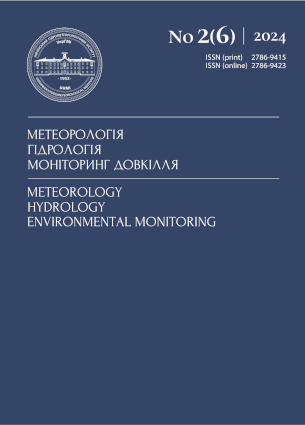Process automation of the long-term forecasting of ice break-up and ice disappearance dates at the Dnipro reservoirs
Ukrainian Hydrometeorological Institute of the State Emergency Service of Ukraine and the National Academy of Sciences of Ukraine, Kyiv, Ukraine
https://orcid.org/0000-0003-4290-3745
Abstract
References
1. Bandorina, L.M., Klymkovich, T.O., &Udachyna, K.O. (2022). Fundamentals of algorithmization and programming: a textbook. Dnipro: UDUNT. [in Ukrainian]
2. Chornomorets, Y.О., Perevozchikov, I.M., Oreshchenko, А.V., & Mala, L.M. (2023). Determination of flow characteristics of the lower Dnipro taking into account the explosion of Kahovka HPP. Meteorology. Hydrology. Environmental monitoring, 2(4), 51–61. http://doi.org/10.15407/Meteorology2023.04.051[in Ukrainian]
3. Gopchenko, E.D., Shakirzanova, Z.R., &Andriyevska, G.М. (2006). Long-term spatial forecasting of maximum spring flow based on an automated computer complex. Nauk. pratsiUkrNDGMI, 255,228–240.[in Ukrainian]
4. Guide to Hydrological Practices (2009). Management of Water Resources and Application of Hydrological Practices. Vol. II. Sixth edition. WMO-No. 168. Geneva: World Meteorological Organization.
5. Khrystyuk, Б.Ф. (2013). The analytical and expert system for the forecasting of the water levels of the navigable part of Danube «Ister». Nauk. pratsiUkrNDGMI, 264, 72–81.[in Ukrainian]
6. Khrystyuk, B. (2017). Short-term forecasting of water inflow to Dniester reservoir using numericalweather forecast model data. In:P.Ninov, E. Bojilova (Eds.), XXVII Conference of the Danubian countries onHydrological Forecasting and Hydrological Bases of Water Management (26-28 September 2017, Golden Sands, Bulgaria), (p. 44).
7. Khrystiuk, Б.Ф. (2023). Automated "Ice-Autumn" system for long-term forecasting of appearance dates of ice phenomena and freeze-up at the Dnipro Cascade reservoirs. Hydrology, Hydrochemistry and Hydroecology, 4(70),39–50. https://doi.org/10.17721/2306-5680.2023.4.3[in Ukrainian]
8. Khrystiuk, B.F., &Gorbachova L.О. (2023). Long-term forecasting methods of dates of ice break-up and disappearance at the Dnipro Cascade Reservoirs by teleconnection indicators. Geophysical Journal, 45(6), 87–101. https://doi.org/10.24028/gj.v45i6.293309[in Ukrainian]
9. Khrystiuk, B., Gorbachova, L., &Shpyg, V. (2022). Verification of the automated flood forecasting systemon the Stryi River. Acta HydrologicaSlovaca, 23(2),234–240. https://doi.org/10.31577/ahs-2022-0023.02.0026
10. Krajewski, W.F., Ceynar, D., Demir, I., Goska, R., Kruger, A., Langel, C., Mantilla, R., Niemeier, J.,Quintero, F., Seo, B.-C., Small, S.J., Weber, L.J.,& Young N.C. (2017). Real-Time Flood Forecasting and InformationSystem for the State of Iowa. Bulletin of the American Meteorological Society, 98(3),539–554. https://doi.org/10.1175/BAMS-D-15-00243.1
11. Lewis, E., Birkinshaw, S., Kilsby, C., & Fowler, H.J. (2018). Development of a system for automated setup of a physically-based, spatially-distributed hydrological model for catchments in Great Britain. Environmental Modelling & Software, 108, 102–110. https://doi.org/10.1016/j.envsoft.2018.07.006
12. Loi, N.K., Liem, N.D., Tu, L.H., Hong, N.T., Truong, C.D., Tram, V.N.Q., Nhat, T.T., Anh, T.N., &Jeong,J. (2019). Automated procedure of real-time flood forecasting in Vu Gia – Thu Bon River basin, Vietnam byintegrating SWAT and HEC-RAS models. Journal of Water and Climate Change, 10(3),535–545. https://doi.org/10.2166/wcc.2018.015
13. Lukyanets, О.І.,&Susidko, М.М.(2004). Integrated basin flood forecasting system in Transcarpathia: methodological and technological basis of its components. Nauk. pratsiUkrNDGMI, 253, 234–249. [in Ukrainian]
14. Maslova, Т.V., &Susidko, М.М. (2007).Estimating the humidity of mountain catchments in mathematical modeling of rain floods. Nauk. pratsiUkrNDGMI, 256, 233–238. [in Ukrainian]
15. Moskalenko,S.О. (2013). Forecasting rain floods on the rivers of right bank of the Pripyat based on modeling of their formation processes. Аvtoref. dys. ...kand. geogr. nauk: 11.00.07. Taras Shevchenko National University of Kyiv. [in Ukrainian]
16. Petzold, C. (2002). Programming Microsoft Windows with C#. Microsoft Press.
17. Prokopenko, О.V., Popov,M.О., &Chumak,H.L. (2024). ProgramminglanguageС/С++. Workshop: a textbook. Kyiv: Taras Shevchenko National University of Kyiv.[in Ukrainian]
18. Pryimachenko, N.V. (2010). Substantiation of the system for calculating flood characteristics on mountain rivers of the Dniester basin based on mathematical modeling of rain runoff formation processes. Аvtoref. dys. ...kand. geogr. nauk: 11.00.07. Taras Shevchenko National University of Kyiv. [in Ukrainian]
19. Resolution of the Cabinet of Ministers of Ukraine. (2023). On the Implementation of the Pilot Project "Construction of the Kakhovka Hydroelectric Power Station on the Dnipro River. Reconstruction after the destruction of the Kakhovka HPP and ensuring the sustainable operation of the Dnipro HPP during the reconstruction period". The Cabinet of Ministers of Ukraine. 18.07.2023. № 730.Retrieved December 24, 2024 fromhttps://www.kmu.gov.ua/npasearch?&num=730&category=3 [in Ukrainian]
20. Shakirzanova, Z.R. (2015). Long-term forecasting of the characteristics of the maximum spring flow of plain rivers and estuaries in Ukraine. Odesa: ТОV «Plyton». [in Ukrainian]
21. Shakirzanova, Z.R., Perevozchikov, I.M., & Shevchenko, O.P. (2023). Application of the method of territorial long-term forecasts to determine the maximum water discharge rates under the conditions of spring flood 2022-2023 formation across the Desna basin. Ukrainian hydrometeorological journal, 31, 5–21. https://doi.org/10.31481/uhmj.31.2023.01 [in Ukrainian]
22. Škerjanec, M. (2022). Automated catchment scale modelling of hydrological phenomena and water quality. Acta hydrotechnica, 35/62, 1–18. https://doi.org/10.15292/acta.hydro.2022.01
23. Susidko, М.М. (2000). Mathematical modeling of runoff formation processes as a basis of forecasting systems. Hydrology, Hydrochemistry and Hydroecology, 1, 32–40. [in Ukrainian]
24. Susidko, М.М, Sherbak, А.V., Zelenska, М.V., &Danylchuk, V.І. (2007). Ice regime of plain rivers and reservoirs of Ukraine. System of short-term forecasting of its characteristics. Hydrology, Hydrochemistry and Hydroecology, 13,62–84. [in Ukrainian]
25. Vishnevsky, V.I., Stashuk, V.А., &Sakevych, А.M. (2011). Water management complex in the Dnieper basin. Kyiv: InterpresLTD. [in Ukrainian]
26. Water Fund of Ukraine. Artificial reservoirs. Reservoirs and ponds. (2014). In:V.K. Khilchevskyi,V.V. Grebin. Kyiv: InterpresLTD. [in Ukrainian]

